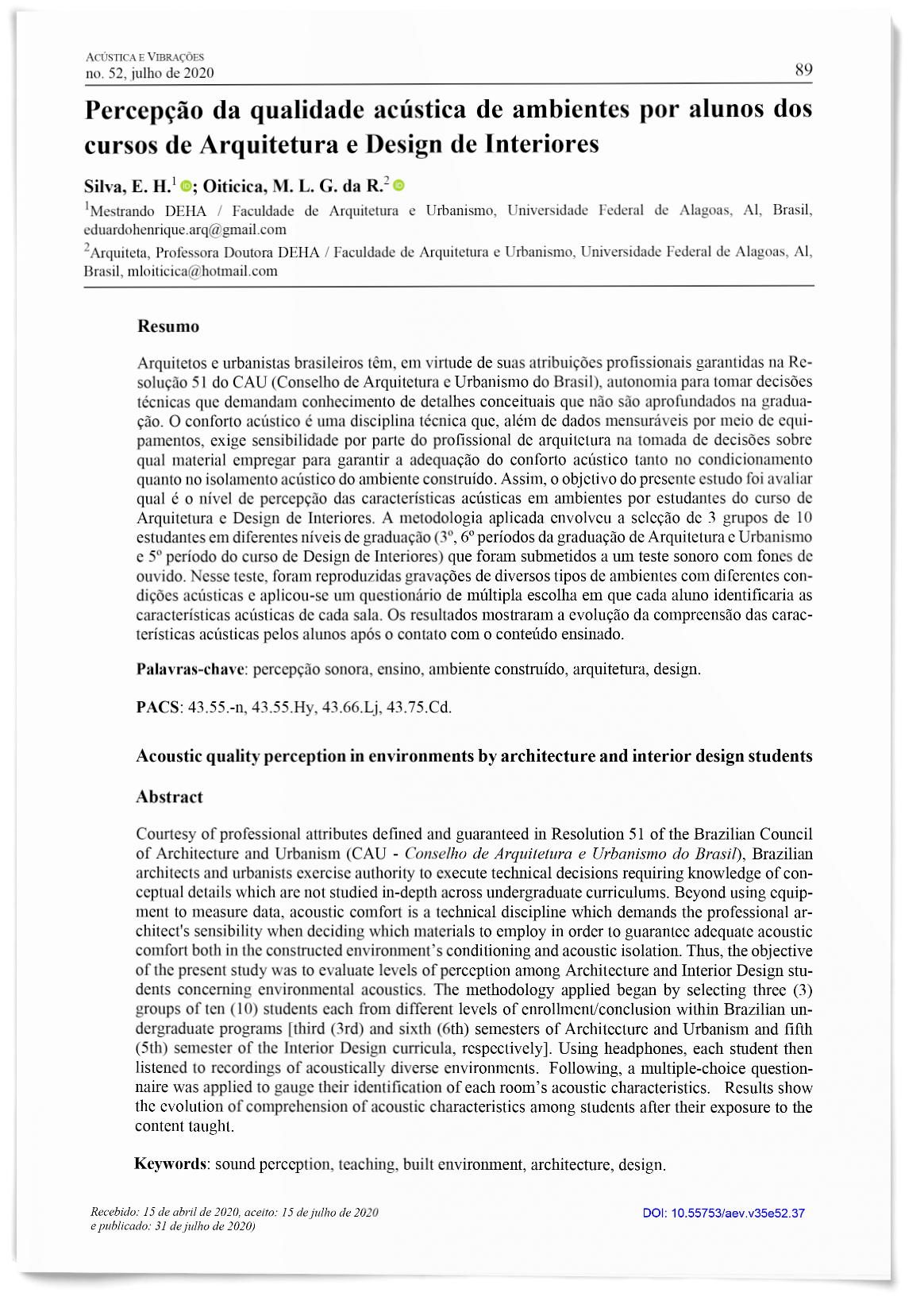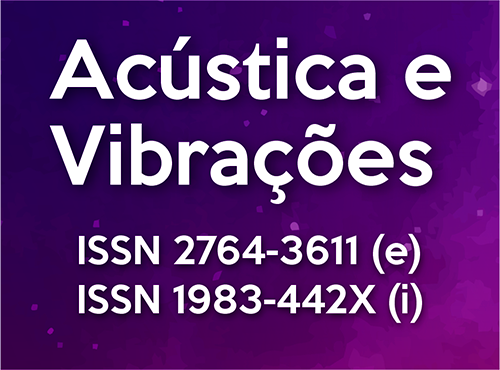Acoustic quality perception in environments by architecture and interior design students
DOI:
https://doi.org/10.55753/aev.v35e52.37Keywords:
sound perception, teaching, environments, architecture, designAbstract
Courtesy of professional attributes defined and guaranteed in Resolution 51 of the Brazilian Council of Architecture and Urbanism (CAU - Conselho de Arquitetura e Urbanismo do Bra-sil), Brazilian architects and urbanists exercise authority to execute technical decisions requi-ring knowledge of conceptual details which are not studied in-depth across undergraduate cur-riculums. Beyond using equipment to measure data, acoustic comfort is a technical discipline which demands the professional architect's sensibility when deciding which materials to em-ploy in order to guarantee adequate acoustic comfort both in the constructed environment’s conditioning and acoustic isolation. Thus, the objective of the present study was to evaluate le-vels of perception among Architecture and Interior Design students concerning environmental acoustics. The methodology applied began by selecting three (3) groups of ten (10) students each from different levels of enrollment/conclusion within Brazilian undergraduate programs [third (3rd) and sixth (6th) semesters of Architecture and Urbanism and fifth (5th) semester of the Interior Design curricula, respectively]. Using headphones, each student then listened to recordings of acoustically diverse environments. Following, a multiple choice questionnaire was applied to gauge their identification of each room’s acoustic characteristics. Results show the evolution of comprehension of acoustic characteristics among students after their exposure to the content taught.
References
BRANDÃO, E. Acústica de Salas: Projeto e Modelagem. 1. ed. São Paulo: Blucher, 2016. ISBN 9788521210061.
ABNT - ASSOCIAÇÃO BRASILEIRA DE NORMAS TÉCNICAS. NBR 10152:2017 Níveis de Ruído para Conforto Acústico. Rio de Janeiro: ABNT, 2017.
ABNT - ASSOCIAÇÃO BRASILEIRA DE NORMAS TÉCNICAS. NBR 12179 – Tratamento acústico em recintos fechados. Rio de Janeiro: ABNT, 1992.
SENADO FEDERAL. Invisível, poluição sonora cresce e se agrava. Jornal do Senado. Publicação em 19.06.2012. Disponível em: http://www12.senado.gov.br/jornal/edicoes/2012/06/19/invisivel-poluicao-sonora-cresce-e-se-agrava. Acesso em: 21 mai. 2017.
DUARTE, E. A. C.; VIVEIROS E. B. Acoustic degradation of buildings along historical evolution of architecture: the construction of a timeline. In: INTERNATIONAL CONGRESS ON ACOUSTICS, 18., 2004, Kyoto. Proceedings... Kyoto, 2004.
PAIXÃO, Dinara Xavier da. Caracterização do isolamento acústico de uma parede de alvenaria, utilizando análise estatística de energia (SEA). Tese de doutorado, Programa de pós-graduação em engenharia de produção, UFSC. Florianópolis. 2002. 182p.
ABNT - ASSOCIAÇÃO BRASILEIRA DE NORMAS TÉCNICAS NBR 15575 – Edifícios Habitacionais. Requisitos Gerais – Desempenho. Rio de Janeiro: ABNT, 2013.
BRASIL, Conselho de Arquitetura e Urbanismo. RESOLUÇÃO N° 51, DE 12 DE JULHO DE 2013 – CAU/BR. Disponível em: http://www.caubr.gov.br/wpcontent/uploads/2012/07/RES51-2013ATRIB-PRIVATIVAS20-RPO-1.pdf. Acesso em: 17 jul 2017.
DARKE, Jane. The Primary Generator and the Design Process. In CROSS, N. (ed.) Developments in Design Methodology. Chichester: J. Wiley & Sons, 1984.
DEHA - UFAL. Proposta do programa de pós graduação. Disponível em: http://www.ufal.edu.br/unidadeacademica/fau/posgra-duacao/mestrado-em-dinamicas-do-espacohabitado/proposta-do-programa. Acesso em: 17 jul 2017.
JACQUES, P. Berenstein. Corpografias urbanas. Arquitextos, São Paulo, ano 08, n. 093.07, Vitruvius, fev. 2008. Disponível em: http://www.vitruvius.com.br/revistas/read/arquitextos/08.093/165. Acesso em: 17 jul 2017.
VORLÄNDER, Michael. Auralization:Fundamentals of acoustics, Modelling, Simulation, Algorithms and Acoustic Virtual Reality. 1. ed. Berlin: Springer, 2008. 335p DOI: https://doi.org/10.1007/978-3-030-51202-6_1
KANG, J. Urban Sound Environment, Taylor & Francis, USA/Canadá, 2007. DOI: https://doi.org/10.1201/9781482265613
VALE, M.I.R.; SILVA, M.G. A metodologia musical de Murray Schafer e sua aplicabilidade em escolas de Educação Básica. In: Educação, Batatais, v. 7, n. 3, p. 81-101, jan./jun. 2017.
SCHAFER, R. Murray. O ouvido pensante. Trad. Marisa Trench de Oliveira Fonterrada. São Paulo: Editora UNESP, 1991.
SCHAFER, R. Murray. A afinação do mundo. São Paulo, Editora da UNESP, 1997.

Downloads
Published
How to Cite
Issue
Section
License
Copyright (c) 2020 Acústica e Vibrações

This work is licensed under a Creative Commons Attribution-NonCommercial-ShareAlike 4.0 International License.




